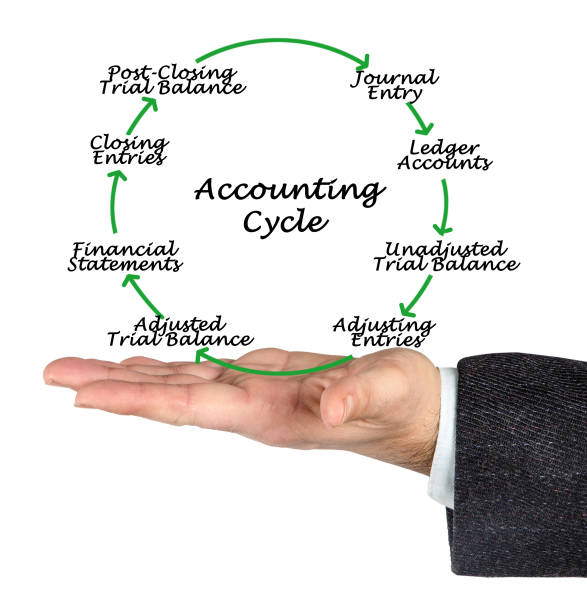
The Main Steps in the Accounting Cycle
Bookkeeping fills in as the foundation of each and every fruitful business, giving a methodical way to deal with record, sum up, and decipher monetary exchanges. The bookkeeping cycle, a key interaction followed by organizations, guarantees that monetary information is gathered, coordinated, and introduced precisely, empowering associations to settle on informed choices and keep areas of strength for a position. In this blog, we will dive into each step of the bookkeeping cycle, clarifying its significance and the job it plays in the in general monetary administration of an organization.
Stage 1: Gathering and Examining Source Records
The bookkeeping cycle begins with the assortment and examination of source archives, which incorporate deals receipts, buy solicitations, bank proclamations, and finance records, among others. These source archives act as substantial proof of monetary exchanges inside the association. The exactness and fulfillment of this data are foremost, as any mistakes or oversights can prompt misdirecting monetary records, possibly influencing navigation and monetary dependability.
During this essential step, bookkeepers fastidiously look at each source archive to guarantee its realness and importance to the association's monetary exercises. Breaking down these records identifies any inconsistencies, disparities, or expected fake exercises, giving areas of strength for a to dependable monetary information and review trails.
Stage 2: Recording Exchanges in the Overall Diary
When the source archives have been verified, the subsequent stage is to keep each monetary exchange in the overall diary. The overall diary is an ordered record that subtleties each exchange in a normalized design. Every diary passage incorporates the date, accounts impacted, a concise depiction of the exchange, and the sums charged and credited.
The twofold section framework, basic to the overall diary, guarantees that every exchange sticks to the central bookkeeping condition: Resources = Liabilities + Value. Each charge should be coordinated with a relating credit, keeping up with the equilibrium of the situation. The overall diary goes about as the essential hotspot for all exchanges, giving an unmistakable and straightforward review trail of the organization's monetary exercises.

Stage 3: Presenting on the Overall Record
In this urgent step, the data kept in the overall diary is moved to the overall record. The overall record includes individual records devoted to explicit resource, obligation, value, income, and cost things. Each record stores the total adjusts of exchanges inside its individual class.
Presenting on the overall record empowers bookkeepers to keep a coordinated and far reaching record of every monetary movement. It works with simple checking of individual record adjusts and gives experiences into the organization's monetary situation at some random time. This step is fundamental for producing exact monetary reports, supporting monetary examination, and guaranteeing straightforwardness in monetary administration.
Stage 4: Setting up an Unadjusted Preliminary Equilibrium
With all exchanges presented on the overall record, bookkeepers set up an unadjusted preliminary equilibrium. The unadjusted preliminary equilibrium records the equilibriums of all records before any changing passages are made toward the finish of the bookkeeping time frame.
The essential goal of the unadjusted preliminary equilibrium is to guarantee that the complete charges equivalent the all out credits, accordingly approving the exactness of the bookkeeping records. On the off chance that the preliminary equilibrium doesn't adjust, it demonstrates that blunders exist inside the bookkeeping sections, requiring revision prior to continuing further.
Stage 5: Making Changing Passages
Toward the finish of a bookkeeping period, changing passages are made to represent different accumulations, deferrals, devaluation, and different changes important to introduce a precise monetary position and execution. These changes guarantee that incomes and costs are perceived in the fitting bookkeeping period, regardless of when money is gotten or dispensed.
Changing passages represent the standards of gathering bookkeeping, which requires income acknowledgment when procured and expenses recorded when brought about, instead of when money is traded. For example, a changing passage might be made to record income procured yet not yet gotten or to designate prepaid costs over the significant periods. Changing passages are significant for sticking to the matching rule, which expresses that costs ought to be perceived in similar period as the connected incomes to give a fair portrayal of the organization's monetary presentation.

Stage 6: Setting up a Changed Preliminary Equilibrium
Following the finishing of the changing passages, bookkeepers set up a changed preliminary equilibrium. This preliminary equilibrium mirrors the refreshed equilibriums after the changes, giving a precise depiction of the organization's monetary position.
The changed preliminary equilibrium goes about as a last check before the budget summaries are ready. It affirms that all exchanges and changing passages have been precisely recorded and that the records are in balance, further approving the exactness of the monetary records.
Stage 7: Producing Budget reports
Utilizing the changed preliminary equilibrium, the bookkeeper can set up the organization's fiscal summaries. The key fiscal reports include:
a) Pay Proclamation: The pay explanation gives a complete perspective on the organization's incomes, costs, and total compensation or misfortune over a particular period. It exhibits the organization's capacity to produce benefits and its functional proficiency.
b) Monetary record: The accounting report presents the organization's resources, liabilities, and value at a particular moment. It gives a depiction of the organization's monetary position and its capacity to meet its commitments.
c) Income Explanation: The income proclamation features the inflows and surges of money during a given period. It uncovers the organization's money creating and cash-polishing off exercises, supporting liquidity examination.
d) Proclamation of Changes in Value: This assertion frames the progressions in the organization's value over a particular period, including commitments, withdrawals, and held profit.
Fiscal summaries are priceless devices for partners, including the executives, financial backers, leasers, and administrative specialists. These assertions assist with assessing productivity, liquidity, dissolvability, and by and large business execution, directing key navigation.

Stage 8: Shutting the Books
Shutting the books denotes the finish of a bookkeeping period and includes moving the equilibriums from the pay and business ledgers to the held profit account. This interaction resets the brief records (pay and costs) to nothing, prepared to amass exchanges for the following bookkeeping time frame. Then again, the monetary record accounts (resources, liabilities, and value) stay unaffected during this interaction.
The end sections guarantee that each bookkeeping period remains solitary, and incomes and costs are not persisted to the ensuing time frame. By shutting the books, the organization keeps up with precise records for each monetary detailing period, working with execution appraisal and correlation of results over the long haul.
Stage 9: Setting up a Post-Shutting Preliminary Equilibrium
After the end passages are made, a post-shutting preliminary equilibrium is ready. This preliminary equilibrium affirms that all impermanent records have been shut, and just the extremely durable records (asset report accounts) convey forward into the following bookkeeping time frame.
The post-shutting preliminary equilibrium fills in as one more essential designated spot to guarantee the precision and respectability of the end cycle. It gives a beginning stage to the following bookkeeping time frame's exchanges, starting another pattern of bookkeeping exercises.
End
The bookkeeping cycle is a complete and methodical interaction that enables organizations to keep up with precise monetary records, produce solid fiscal summaries, and pursue very much educated choices. From gathering and examining source reports to producing fiscal summaries and shutting the books, each step assumes a vital part in making a total and straightforward monetary image of the association.
By tirelessly following these means, organizations can unhesitatingly explore the intricacies of bookkeeping, adjust to developing monetary scenes, and keep steady over their monetary wellbeing. With hearty monetary information and good to go explanations, organizations can decisively make arrangements for the future, enhance asset distribution, and accomplish supportable development and flourishing. Embracing the bookkeeping cycle as an incredible asset is fundamental for any association trying to flourish in the present cutthroat business climate.







0 Comments